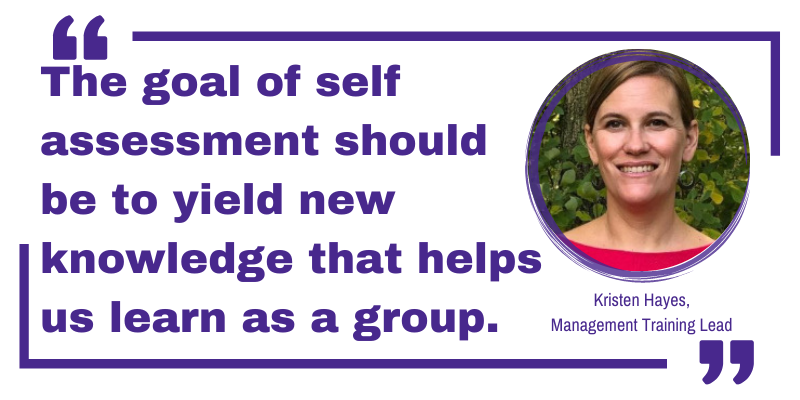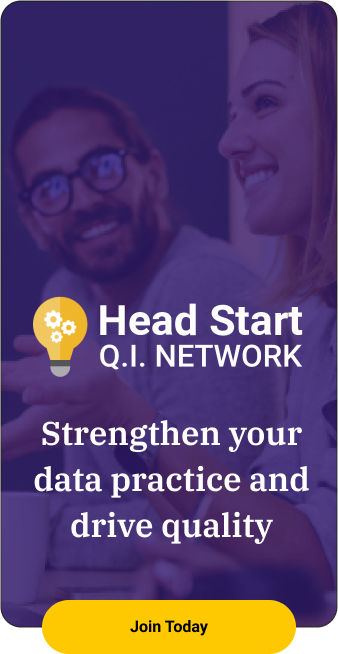Head Start programs are required to conduct an annual self-assessment. While they’re often an afterthought, Head Start self-assessments can be a valuable planning tool, a means to thinking about data collection, and a learning opportunity. The latter is key, according to Kristen Hayes, Management Training Lead at Early Intel. “The goal of self assessment should be to yield new knowledge that helps us learn as a group, and then ultimately transform ourselves,” she says.
As a former federal project officer for the Office of Head Start, Hayes read a lot of grants, including self-assessments. “Now as a consultant, I get to help people think about how to structure and execute their self assessment,” she adds.
Head Start and Early Head Start programs approach self-assessment very differently. Even among different Head Start programs, there are many variations in approach depending on where the program is in its five-year grant cycle, the size of the organization, and other factors.
Below, Hayes shares some overarching strategies to help guide Head Start self-assessments.
Step #1: Ask a question
Self-assessments should start by asking what you want to learn or what you want to know. Hayes offers some examples of questions a self-assessment might explore:
- Are children exiting our program ready to enter kindergarten?
- Are families better off as a result of our services?
- Are our services aligned with community needs?
- Are the child care partners/delegates delivering services in accordance with their contract and the HSPPS?
- Are we supporting our child care partners/delegates in the ways we said we would?
- Did an organizational restructure result in better supports for our staff?
Once you’ve chosen a question, move onto step #2.
Step #2: Determine the data needed to answer the question
Hayes stresses the importance of focusing on the data needed to answer the question, not whatever data you have that might fit the question.
Depending on the question you’re asking, this data might include some combination of the following:
- Enrollment, attendance, wait list
- Observation of classroom environments and teaching practices
- Child-level outcomes
- Family-level outcomes
- Feedback from parents
- Feedback from staff
- Feedback from child care partners/delegates
If you already have the data you need to answer the question, great! You can skip to step #4. If not, continue to step #3.
Step #3: Collect the data (if it doesn’t already exist)
Good data collection is planned and intentional in what data you collect and how you collect it. To be useful, it also needs to be accurate. Here are some data collection strategies to consider depending on the question you’re exploring:
- Data entry into ChildPlus/COPA/GoEngage
- Data entry into TSG, DRDP
- Classroom/home visit observations
- Surveys
- Focus group
After you’ve collected data to answer your question, you’re ready for step #4.
Step #4: Analyze the data
Self-assessments create an opportunity to engage a variety of stakeholders, not just program leadership. Look at who is involved in this work and the roles of Head Start staff, agency staff, board and Policy Council members, and external supports such as consultants and contractors.
As you’re analyzing data, remember these tips:
- Two data points are not a trend!
- Reviewing data holistically instead of focusing on a few data points can yield more helpful insights.
- Sub-group analysis can provide a deeper understanding of how children and families are experiencing the program (for example, dual language learners).
Analysis may lead to more questions, and that’s OK. This sometimes frustrates program leaders but true self-assessment never ends, because it’s ongoing.
Step #5: Use the data to guide decisions and actions
Finally, consider what your findings tell you about your question:
- What are the possible next steps in response to the data?
- How will financial resources be allocated in support of next steps?
- How will you reach consensus on how to move the work forward?
- Who will own this work going forward?
- What progress monitoring routines will you use to share information with key stakeholders?
Lasting change requires consensus. “It’s never going to be enough for one person to own and champion the change,” Hayes says. When the team collectively takes ownership of growing and changing for the better, that’s when meaningful improvements stick.
Head Start self-assessments are complex and nuanced but hopefully these steps give you a starting point for thinking about the process. Ultimately, self-assessments are about learning something new, enabling leaders and staff to transform their organization and better serve the community. When programs embrace self-assessments as a growth opportunity rather than a chore or obligation, they gain stronger program outcomes and a program culture of inquiry and improvement.


